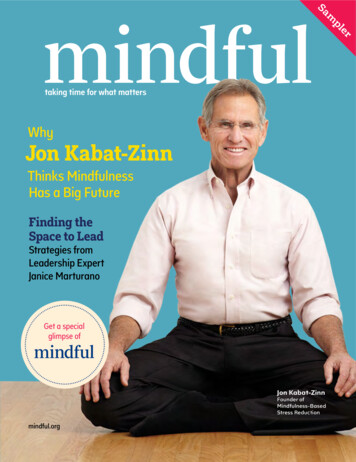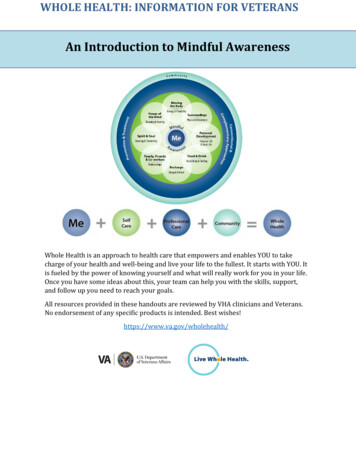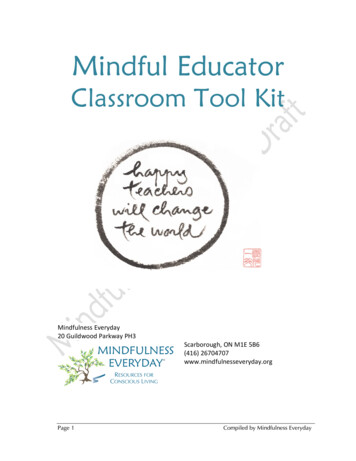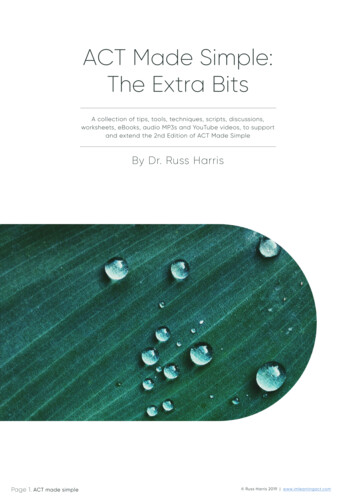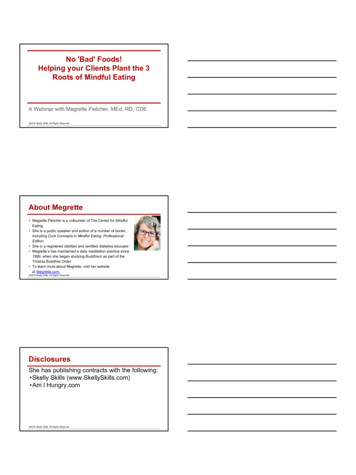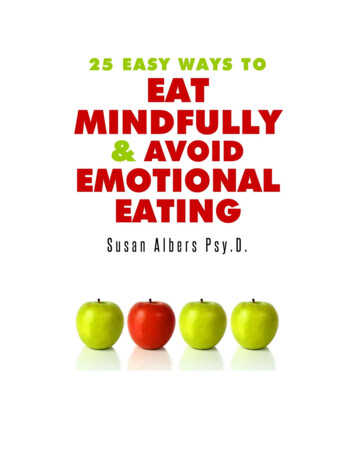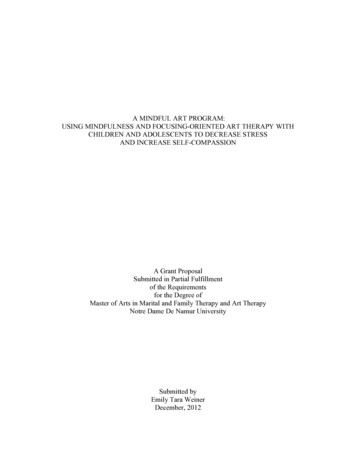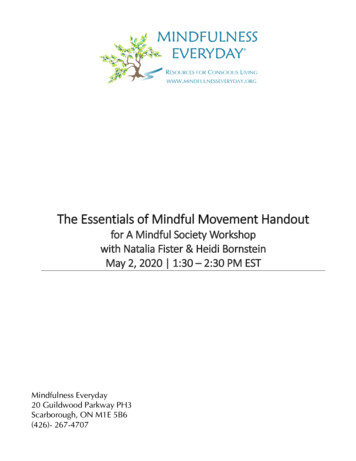
Transcription
The Essentials of Mindful Movement Handoutfor A Mindful Society Workshopwith Natalia Fister & Heidi BornsteinMay 2, 2020 1:30 – 2:30 PM ESTMindfulness Everyday20 Guildwood Parkway PH3Scarborough, ON M1E 5B6(426)- 267-4707
ContentsThe Essentials of Mindful Movement Handout for A Mindful Society Workshop with Natalia Fister &Heidi Bornstein May 2, 2020 1:30 – 2:30 PM EST . 1Contents . 1Mindful Yoga and Mindful Movement . 1Working with the Breath . 1Eyes Open or Closed . 1Cautionary . 2Language & Cueing . 2Expanding Limitations . 2Acknowledging Transitions . 3Awareness of Sensation . 3Working with Pain . 3Benefits of Mindful Movements . 3Language and Cueing . 4Imbedding the attitudes of mindfulness into conscious movement. 6
20 Guildwood Parkway Ph3,Scarborough, ON M1E 5B6(416) 267-4707Mindful Yoga and Mindful MovementMindfulMovementMindful Yogabringing mindfulnessto traditional posesbringing mindfulnessto functionalmovementIntersect HEREAttitudes of MindfulnessLanguage and CueingTrauma Informed( i.e. meeting peoplewhere they are at withcompassion andheartfulness)Working with the Breath In mindful meditation, we simply notice the breath, without manipulating it in any way, justobserving it moment to moment. In mindful movements, the instructions may call for an inbreath or an out-breath to be used in conjunction with a particular movement, while observingthe sensations and feelings in the body.If discomfort is experienced, it can be attended (or be with it) on an in-breath. Breathing intothese regions, with a gentle, curious, nurturing attention on an in-breath. On the out-breath,allowing the body to soften, letting go of any sense of resistance or holding.Eyes Open or Closed Work with the eyes open sometimes and closed at other times as you see fit, experimentingwith your ability to observe and the level of concentration you can achieve.Mindful Movements Guidelines Page 1
20 Guildwood Parkway Ph3,Scarborough, ON M1E 5B6(416) 267-4707Cautionary Be in tune with your own awareness of what is right for you, rather than pushing beyond limitsor being critical and judgmental of your movements. Practicing on the side of caution – nevergoing to the point of strain or pain. If the instructions given do not seem right for you, trustyour own awareness and do what feels right.Bringing the spirit of gentleness, kindness and compassion to yourself.Every body is different; mindful movements are not about comparing or competing. Everyone isinvited to work at their own level, exploring their own range of movement.If you feel that any of the work is not appropriate for you at this time then just close the eyes,and visualize or sense doing it in as much detail as possible. This has been shown to providesubstantial benefit even though it’s completely passive.Working with the breath: When we experience discomfort, we can attend it (or be with it) onan in-breath, by breathing a gentle, curious, nurturing attention into these regions while on theout-breath, allowing ourselves to soften into it, letting go of any sense of resistance or holding.Work with the eyes open sometimes and closed at other times as you see fit, experimentingwith your ability to observe and the level of concentration you can achieve.Remembering the intention of this practice: to become aware, as best we can, of physicalsensations and feelings throughout the body as we engage in a series of gentle movements,honouring and investigating the limitations of our body in every moment, as best we can,letting go of any tendency to push beyond our limits or to compete with either ourselves orothers.Language & Cueing Present continuous tense vs imperativeInvitational, spacious, offering variations and options, clear explicit instructions of what toexpectExploring, noticing, playing, being aware of, being curious, letting your body guide yourpractice, finding the balance between effort and ease, dropping into physical sensation,dropping in to the breath, checking in with physical sensation – do you need more or less, tendand befriend the unpleasant, you might – maybe – perhaps, what happens when/if, if thesensation is unpleasant, can you practice self-compassion, until your body tells you to stop, asbest you can – stopping when you reach your limit – if it’s ok with you – if it’s available to you –checking in –stretching – lengthening – extending – reaching – elongating – unfolding – expanding –contracting – compressing – releasing – letting go – opening – softeningExpanding LimitationsMindful Movements cultivate strength, balance and flexibility, in which each person can explore anddiscover his or her own limits, without striving to change anything. By bringing awareness to the body andworking within its limits, the limits tend to recede over time.Mindful Movements Guidelines Page 2
20 Guildwood Parkway Ph3,Scarborough, ON M1E 5B6(416) 267-4707Acknowledging TransitionsBringing Mindful Awareness in the movement between positions. And allowing for time to integrate.Awareness of SensationNoticing sensation and the qualities of sensations, observing areas of expansion and compression, as well asdifferences between left and right sides of the body. Being able to “feel” rather than think about sensations.Working with PainNoticing and describing sensation, investigating with a sense of curiousity and interest, rather than pullingaway, attending and befriending. Is there is centre to the pain?Is there a border to the pain – can you detect where it begins and ends?Does the sensation shift or change with observation?Being aware of associated thoughts.Suffering pain x resistanceBenefits of Mindful Movements An important part of mindfulness practice involves getting in touch with the body. MindfulMovements give one ‘louder’ sensations to tune in to, making it easier to connect with thebody.Mindful Movements helps one to accept the body just as it is in the moment, and one’s ownlimitations in the moment. This, in turn, helps one develop increased patience and overall selfacceptance.Getting reacquainted with your body is one of the most effective ways to begin to understandthe concept of being in the moment. Many of us take our body and its functioning for grantedin spite of the fact that it is miraculous in the way it operates, regulates and heals itself.Try to see this exercise as a continuous process moving mindfully and gracefully from oneposture to another, the breath establishing the tempo as if it were a dance, not a series ofunconnected events.We almost invariably encounter at least some degree of bodily discomfort while practicingstretching through mindful movements. This makes this practice such an effective way forlearning how to approach difficult and unwanted moments and experiences with greateracceptance, curiosity, gentleness, and kindness. As well, the skills developed in working witheven a mild degree of physical discomfort can be directly applied to situations of more intenseemotional discomfort.Redistribution, replication or commercial use is prohibited without expense written permission of Mindfulness Everydaywho is the sole owner and copyright holder of this property.For more information on educational programs and materials, please contact us at info@mindfulnesseveryday.orgMindfulness Everyday is a registered Canadian charity #83693 3507 RR0001Mindful Movements Guidelines Page 3
20 Guildwood Parkway Ph3,Scarborough, ON M1E 5B6(416) 267-4707Language and Cueing1. Invitational, offering variations and options:“Closing the eyes—or not”“Choosing the variation most appropriate for your body in this moment”“If this is available to you”“It’s just an invitation”“Playing, exploring, moving into, adventuring (trying something new)”2. Present continuous tense vs imperative“Lowering the leg to the floor” vs “Lower your leg”.3. Avoiding negative languaging.“Resisting the urge to round the back” vs “Don’t round the back.”4. Clear explicit instructions of what to expect. (Length of time, types ofmovements, lighting, props, etc.)“The conscious movement portion of the class today will be 20 minutes.I will be dimming the lights and providing you with a blanket and strap for your comfort. Wewill be doing gentle, functional movements and offering several variations each time to honourthe diverse and unique bodies showing up in class today. Trust the intuition of your body toguide you through each movement, never compromising the well-being of your body. Doesanyone have any questions before we begin?”5. Avoid these cues: Rolling up or down through the spineDropping the head back.Pulling the shoulder into the socket (should be pulling the arm into the socket)Non-secular words like Namaste (unless expanded to include other cultures /. Religions/ spiritual traditions)6. Contraindications to be aware of: Forward bending with a rounded back (vertigo, migraines, osteoporosis or osteopenia,glaucoma)Rounding of the backWrist strain (options of using fists)Hyper extension of knees, of neck, of elbowsShoulder girdle stability (when raising arms, keeping arms in shoulder sockets)Rotator cuff injuries (work within your limits – smaller, less intense movements)Mindful Movements Guidelines Page 4
20 Guildwood Parkway Ph3,Scarborough, ON M1E 5B6(416) 267-47077. Introductory explanation of the philosophy of mindful movement. The purpose of today’s movement class is not to get a “workout” but to build on thebody, mind, breath connection, to connect the dots so to speak.The suggestion is to work within the body’s limits at all times, with the intention ofobserving and exploring the boundary between what the body can do and where it says,“Stop for now.” Never stretch or contract beyond this limit to the point of pain.Can you give yourself permission to skip a pose if your body feels it isn’t right for you?You might find yourself at some point comparing yourself to others in class. This ishuman nature, but can you challenge that thought, asking yourself: Is this a helpfulthought? Is this a compassionate thought?Allowing the body to guide the movements and not the ego mind.If you experience any unpleasant sensations or emotions, the invitation is to practiceself-compassion, attending and befriending that sensation, treating it as valuableinformation in developing the mind-body connection.8. Closing comments/questions for the group: What did you notice about your body today?What was your rose (enjoyable) ? What was your thorn (challenging or unpleasant)?Did anyone find themselves judging his/her body or its abilities? Feeling frustrated?Irritated by a particular movement? Welcome to being human!Did anyone notice that their attention wandered? Welcome to being human.Was there a cue or phrase that was particularly helpful?Mindful Movements Guidelines Page 5
20 Guildwood Parkway Ph3,Scarborough, ON M1E 5B6(416) 267-4707Imbedding the attitudes of mindfulness into conscious movementAwareness CuriosityBeginner’smind Kindness&CompassionNonjudging Patience Checking in with/dropping into physical sensationDropping into the breath—what is the quality of the breath right now?Do you notice any emotion percolating up in this posture? Calm? Frustration?Anger? Curiosity? And can you be with that emotion without judging it?In this pose . exploring noticing.playing with . being aware of . beingcurious,You might notice– maybe this feels perhaps you are feeling what happenswhen/if .Staying curious, as if we are doing this posture for the first time.Being curious about our bodies every time we practice; our bodies areconstantly changing, moment by moment.Asking yourself, “What wants my attention?”Being curious about our response to the posture each and every time; ourpractice, our bodies, and our response to the practice is always evolving.Staying curious!Thinking of yourself as a scientist in the laboratory of your own body,experimenting and investigating with curiosity.Can you try this pose without expectation of how it should be?Exploring what it means to “meet my edge and soften.”If you experience any unpleasant sensations, can you practice selfcompassion?Can you choose the variation that feels most compassionate to your body?Asking yourself, “Is this is a healthy challenge for my body?”Moving slowly into the pose until your body tells you to stop.If an unpleasant sensation percolates up, instead of judging it, attend andbefriend it. Be curious. Breath into the area of discomfort nurturing it withyour breath. Perhaps not going as deeply into the movement.Do you finding yourself judging your flexibility/strength/mobility/sensations inthis posture? Can you shift from judgment into curiosity?Has your mind wandered? This is normal. You are human. No need to judgethe wandering mind. Just inviting the wandering mind back to the room,relaxing back into the breath, back into physical sensation.If you become aware of an unpleasant emotion rolling up, can you suspendjudgment and just be with it?Entering and exiting the postures slowly, mindfully, with the breath. Slow andsure wins the race. Except there is no race.Using finesse not force; this avoids injuries and pain.Letting our body unfold at its own natural pace.Mindful Movements Guidelines Page 6
20 Guildwood Parkway Ph3,Scarborough, ON M1E 5B6(416) 267-4707If any one pose doesn’t feel right, trusting the wisdom of our bodies, and givingourselves permission to not do it. Please put up your hand for a variation if this/any pose doesn’t feel right. Checking in with physical sensation – do you need more or less sensation? Choosing this variation only if it’s available to you. Trust your body to guideyou in this decision. Choosing the variation most appropriate for your body in this moment” Pausing and doing the 3 bears test: Is this variation “too little?”, “too much?” or“just right?” Can you try this pose without any expectations, without being attached to theoutcome? Final relaxation is a great pose to practice non-striving Can you find the balance between effort and ease? Attempting the posture as best you can – stopping when you reach your limit. Accepting the limitations of our bodies, not trying to change anything in themoment of doing a pose; instead, observing it all with kind and curios attention. Conscious movement/yoga isn’t about self-improvement—its about selfacceptance Accepting that it is the nature of our mind to wander, missing instructionalcues; we simply re-focus when we catch our mind wandering and anchor backto breath and physical sensation. TrustNonstrivingAcceptanceOnce we exert the effort to get into the posture, we let go, “melting into it”,surrendering to the wisdom of our body and breath. We let go of any ideas of the “perfect yoga pose”. We suit the pose to ourbody, not our body to the pose or some perceived state of perfection. In final relaxation, we let go of controlling our body & breath, letting go, lettinggo. Let’s thank ourselves for committing our time and effort to this practice,contributing to the peace of the planet through our practice. Thanking the miracle of our body. Taking this opportunity to thank others in the class for sharing theirlight/energy and contributing to the creation of a peaceful and lovingcommunity. Thanking all our teachers, past present and future. If an unpleasant sensation percolates up, can you thank your body for providingyou with this information so you can better attend and befriend it. Letting goGratitudeMindful Movements Guidelines Page 7
Mindful Yoga Teacher Training 2020 – MindfulnessEveryday.org9 Attitudes of Mindfulness Place MatBeginner’s mindPatienceNon-judgingAttitudeOn the Cushion Being an impartial witness of ourown experience requires that webecome aware of the constantstream of judging and reacting toinner and outer experiences thatwe are normally caught up in,observing it, and stepping backfrom it. A form of wisdom, itdemonstrates that we accept thefact that sometimes things mustunfold in their own time. We intentionally remind ourselvesnot to be impatient with ourselvesbecause we are tense or agitatedor frighten--especially ourwandering mind duringmeditation. An open, beginner’s mind allowsus to be receptive to newpossibilities and prevents us fromgetting stuck in the rut of our ownexpertise. No moment is the sameas any other–each one is uniqueand contains unique possibilities. Are we able to see the sky, thestars, and the trees, with a clearand uncluttered mind?On the MatIn the World Avoid “stinking thinking”. For ex,“Why am I so inflexible”, “Thatperson has a better downwarddog than me”, “Why can’t I ” Instead, endeavoring to observeour bodies with curiosity andkindness Choosing self-compassion overself – judgement, especially inregards to aches and pains,physical limitations, ourwandering minds. Entering and exiting the posturesslowly, mindfully, with the breath. Using finesse not force; this avoidsinjuries! Always being SAFE! Slow and surewins the race. Letting our body unfold at its ownnatural pace. Becoming aware of the constantstream of judging and reacting toinner thoughts and outerexperiences. We are constantlyjudging things, people & ourselvesas either being “good “or “bad”. Mindfulness encourages us tostep back from it and observe it allwith kindness and curiosity. Staying present, as if we are doingeach posture for the first time Being curious about our bodiesevery time we practice; our bodiesare always changing. Being curious about our responseto the posture each and everytime; our practice, our bodies, andour response to the practice isalways evolving. Staying curious! Challenging our habits is one wayto foster beginner’s mind: Sittingin a different chair, folding ourhands in the opposite way,brushing our teeth in a differentpattern, trying new things. This also means trying old thingswith a new eyes, new ears, newtaste buds. For example, eating astrawberry as if it were the firsttime.All Rights Reserved – Created by Natalia Fister & Heidi Bornstein Mindfulness EverydayWhat comes toMind? Being patient with ourselves andothers, especially whenchallenged. When things don’t go our way,instead of reacting withimpatience, responding by seeingit as an OTP moment: Opportunityto Practice mindfulness.Page 8
Mindful Yoga Teacher Training 2020 – MindfulnessEveryday.orgNon-strivingTrust9 Attitudes of Mindfulness Place Mat Developing a basic trust inourselves and our feelings is anintegral part of meditationtraining. Trusting in our meditationpractice—that whatever “showsup” belongs, and that it is all “gristfor the mill”. Meditation’s only goal is for us tobe ourselves (which we alreadyare! We just have to “feel it”). Sometimes we try too hard whenwe meditate. We grip too hardaround the goal of “stilling thewandering mind”. When we catch the mindwandering, we relax back intopresence. Entering the posture slowly to seeIf it feels right for our own uniquebody If it doesn’t feel right, we don’t doit, trusting our intuition, thewisdom of our own body, over theauthority of the teacher. Asking the teacher for a variationwhen something doesn’t feelright. Not competing with fellowstudents or comparing ourselves. Trying a yoga pose but beingunattached to the outcome. It isnot important to do any onevariation of the pose. Not trying to get into a pose weare not ready for—we just end uphurting ourselves. Sivasana (final relaxation) is agreat pose to practice non-strivingAll Rights Reserved – Created by Natalia Fister & Heidi Bornstein Mindfulness Everyday It is far better to trust in ourintuition and our own authority,even if we make some mistakes,than always looking outsideourselves for guidance. Trusting in our own intrinsicgoodness. Mindfulness invites us to a newway of seeing ourselves, wherewe are trying less and being more. We are not “human DOINGS”after all we are “human BEINGS”. Mindfulness invites us to BE moreby DOING less. Observe moments in our daywhere we are perhaps grippingtoo hard around an outcome/goal, and loosening that grip.Page 9
Mindful Yoga Teacher Training 2020 – MindfulnessEveryday.orgLetting goAcceptance9 Attitudes of Mindfulness Place Mat We accept things as they are inthe present moment, especiallyOURSELVES, instead of wantingpeople/events to be different. When meditating, unpleasantsensations and thoughts can arise.These are opportunities topractice not only accepting theunpleasant, but even leaning intoit, so when these moments arisein life, we can respond to theminstead of react. We can practice saying, “This toobelongs” to unpleasantness,recognizing it as part of thehuman condition. When we meditate we startpaying attention to our innerexperience. We rapidly discover that there arecertain thoughts and feelings andsituations that the mind seems towant to hold on to and others thatwe try to get rid of. In mindfulness, we let ourexperience be what it is. Lettinggo is a way of letting things be asthey are. This sets the stage forletting go of perfectionism,judgements, the past, people inour lives etc. Accepting the limitations of ourbodies, not trying to changeanything; instead, observing it allwith kind and curios attention. Yoga isn’t about selfimprovement—its about selfacceptance Accepting that it is the nature ofour mind to wander, missinginstructional cues, etc. We simply re-focus when wecatch our mind wandering andanchor back to breath andphysical sensation. Once we exert the effort to getinto the posture, we let go,“melting into it”, surrendering tothe wisdom of our body andbreath. Yoga is finding the balancebetween this effort and ease. We let go of any ideas of the“perfect yoga pose”. We suit theyoga pose to our body, not ourbody to some perceived state ofperfection. In sivasana, final relaxation, we letgo of controlling our body &breath, letting go, letting go.All Rights Reserved – Created by Natalia Fister & Heidi Bornstein Mindfulness Everyday Practicing accepting the presentmoment in the course of our dailylives. We often waste a lot of energydenying and resisting what isalready fact (for ex, a pastexperience, like a relationshipending, or a perceived injustice). Mindfulness encourages us toaccept the present moment witha sense of equanimity,understanding that we grow fromall experiences, most importantlyfrom challenging ones. This doesnot mean accepting injusticesBTW. In our lives, we might startnoticing that we are better able tolet our experience be what it is,letting go of limiting expectations(“my friend should act more likethis” or “If only I could have this then I will be happy” and “I haveto achieve this goal to feelsuccessful”) . Letting the present moment bewhat it is sets the stage for lettinggo of perfectionism, judgements,the past, certain people etc. Letting go does not mean givingup; it means freedom fromreactivity.Page 10
Mindful Yoga Teacher Training 2020 – MindfulnessEveryday.orgGratitudeGenerosity9 Attitudes of Mindfulness Place Mat Carving out the time each day fora meditative practice is an act ofgenerosity to ourselves and toothers. We are cultivating ourequanimity, so that we can play itforward and be an anchor of calmand peace for those around us. We are gifting ourselves andothers at the same time Similarly, committing to a regularyoga practice is act of self-carethat benefits us and those aroundus. When we practice self-care, wemodel it for others and inspirethem to practice self-care as well. We can also be generous byencouraging others in class,smiling, connecting before andafter class, etc Can we be grateful for all ourmeditation practices? Even themost challenging ones whereunpleasant thoughts, feelings, andphysical sensations may havepercolated to the surface? As Jon Kabbat Zinn says, if we arebreathing, there is more right withus than wrong. Grateful for the ephemeralglimpses of freedom we aregifted. Thanking ourselves for committingour time and effort to thepractice, contributing to the peaceof the planet through our practice. Thanking the miracle of our body. Thanking the people in the classfor bringing their light/wonderfulenergy into the room, creating apeaceful and loving community. Thanking all our teachers, pastpresent and future.All Rights Reserved – Created by Natalia Fister & Heidi Bornstein Mindfulness Everyday This is the virtue of beingunattached to materialpossessions, often symbolized bythe giving of gifts, the virtue ofgiving good things to others freelyand abundantly. But it also means being generouswith our time and undividedattention which fosters deep &authentic connection. This also means being generouswith ourselves, nurturingourselves, practicing self-care,giving ourselves the gift of time,of non-doing and just being. This is the quality of beingthankful, the readiness to showappreciation for all the small,moment to moment experiencesin life like a snowflake landingon our tongue on a bright winterday, or sitting down to a goodmeal with family and friends, orlooking into the eyes of anadoring pet. Savoring it all! Nottaking any of it for granted. Gratitude journals rock!Page 11
Mindful Yoga Teacher Training 2020 – MindfulnessEveryday.orgForgiveness9 Attitudes of Mindfulness Place Mat Forgiving our wandering mindwhen we meditate—it was DNA’dto do this! Attending and befriending thehurt that often rolls up when wemeditate. If we can practiceleaning into the pain, instead ofrecoiling from it, we cansometimes find our way toforgiveness. Forgiveness can be a road tofreedom, but only if we are readyand don’t force it—otherwise itcan feel imprisoning, just onemore crushing expectation we putonto our shoulders. Forgiveness might not always bepossible and should never berushed or an expectation we haveof ourselves. Forgiving ourselves for not alwaysachieving the perfect yogaposture! Forgiving the person beside uswho we perceive as achieving theperfect yoga pose—grrrr! Forgiving our wandering mind—itwas DNA’d to do this! Forgiving the perceivedimperfections of our body. Forgiving ourselves for not alwaysbeing in the “perfect mood”during yoga. Forgiving ourselves for beingrestless in Sivasana instead ofblissed out and relaxed. Forgiving our yoga teacher for notalways being the perfect yogateacher All Rights Reserved – Created by Natalia Fister & Heidi Bornstein Mindfulness Everyday Before we begin to forgive otherpeople, we need to forgiveourselves for all our wonderfullyhuman imperfections. “What islife but a series of experiments,mistakes and failures.” We learnfrom these experiences. Theykeep us humble and allow us tofeel empathy for others when wesee them making similar mistakes. When someone has hurt us,forgiveness becomes a process.We have to give ourselves time toheal from the wound. Butforgiveness is something we dofor ourselves, not the otherperson, so that we can be free ofthe past.Page 12
Attitudes of Mindfulness. Language and Cueing. Trauma Informed ( i.e. meeting people where they are at with compassion and heartfulness) Mindful Movement bringing mindfulness to functional movement. 20 Guildwood Parkway Ph3, Scarborough, ON M1E 5B6 (416) 267-4707. Mindful Movements Guidelines Page 2 .


